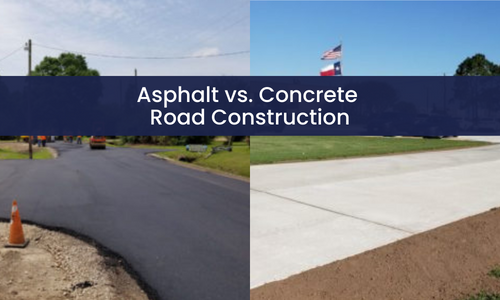Asphalt and concrete are both top choices in road construction, and almost all of the roads you’ll drive on are made from one of these materials. Cost, maintenance, durability, performance – each has their pros and cons, so there isn’t a clear winner between asphalt vs. concrete road construction.
Which material will work best for your project? That depends on several factors.
What Are The Advantages and Disadvantages of Asphalt Roads?
An asphalt road surface offers a smooth and quiet ride, and it holds up better in certain weather conditions. Asphalt’s black color means it warms up quickly when exposed to the sun, and this heat will accelerate ice and snow melt. Asphalt is less slippery in the rain and snow, too, offering better skid resistance, traction and motorist safety. There are also installation and maintenance costs to consider. Compared to concrete, asphalt roads are a bit less expensive to place and can be installed quickly. Asphalt roads can also be repaired quickly. The equipment required for asphalt road repair is simple and available to smaller municipalities, so asphalt is a popular option for rural and suburban areas.
However, there are some issues with asphalt that prevent it from being the only option in road construction. Though asphalt is inexpensive, it doesn’t last nearly as long as a concrete road. It’s less durable as well, with a greater tendency to develop potholes and cracks. Asphalt may also soften when the heat’s on, reducing performance for any vehicles that drive on it.
What Are The Advantages and Disadvantages of Concrete Roads?
Concrete is a durable, reliable material to make roads out of, and it holds up better than asphalt under heavy traffic conditions. Concrete is less likely to suffer from rutting, cracking, potholes and loss of surface definition. This durability advantage means concrete is needed for roads that see a lot of traffic (especially commercial traffic). It’s also needed for roads that have a lot of bends in them, as concrete will not break down due to tension.
Compared to asphalt, concrete is far more resistant to heat, so it may be the only realistic option in hot climates. Concrete pavement also offers a much longer lifespan than asphalt, and its manufacturing results in less pollution. While an asphalt road should last around 10 years, a concrete road can hold up for 40 years or more.
There are some compelling durability benefits with concrete, but there are some challenges as well. Concrete is more costly to maintain than asphalt, because when concrete road repairs are needed, entire concrete slabs will need to be replaced. Concrete roads take several days to cure, too, which means the road isn’t usable right away. There are types of concrete that cure faster (within a day or two), but they don’t possess the same level of strength.
Concrete and Asphalt Each Have Their Role in Road Construction
Between concrete and asphalt, there is a material solution for every roadway. Asphalt is a frontline choice for rural and suburban projects, where less traffic is expected. It can also be used in cities, though typically on smaller side roads.
Concrete is built for heavy traffic conditions, which is why most interstates are built with concrete slabs. Concrete is a popular choice for busy urban streets, too, as it can withstand commercial trucks with ease. In areas where roads have to bend, rise and drop, concrete is a better choice with its durability advantage.
How Are Concrete Roads Built?
Concrete is produced from a mix of aggregate (sand, gravel, etc.), Portland cement and water. The cement base includes a combination of high-lime content materials, like limestone or chalk, and high-silica materials, like clay or shale.
First, the road’s subgrade is prepared. The subgrade consists of the natural soils that sit immediately below the concrete layers, and it must be graded, leveled and watered before it’s ready to take concrete. Additional layers are placed on top of the subgrade, including the subbase and base courses, both of which are made using crushed aggregates. These layers provide additional support, load bearing, and drainage capacity for the concrete slab.
On top of the subgrade, subbase and base layers, the surface course sits. The surface course is the concrete slab that vehicles will contact directly, so it must be durable and protect underlying layers from moisture.
The concrete slab is mixed and poured onsite, and then allowed to cure for several days. Once cured, the road is ready to go.
How Are Asphalt Roads Built?
Asphalt roads don’t require quite as much work, but they’re not as simple as they look. Before asphalt can be rolled out, the ground must be graded to ensure adequate drainage and road stability.
Like with concrete roads, asphalt roads also require a base layer for better weight bearing and durability. This base layer typically consists of gravel, crushed limestone or crushed granite, and it must be several inches thick to support the road.
A binder layer goes over this and consists of oil and large pieces of aggregate. The binder provides much of the road’s strength and holds the asphalt in place. Once the binder is layered, the asphalt goes over the top and is a mix of sand, oil and tiny pieces of aggregate.
American Parking Control Works With Concrete and Asphalt
There are significant differences between asphalt and concrete construction, but American Parking Control has extensive experience with both. Further, it’s likely that your new road will need to be connected to a parking lot, a driveway or to other existing roads – which takes additional expertise.
With nearly 40 years of experience in concrete and asphalt road construction, our team can provide this expertise for your road building project.
- HOA & Condos – How Asphalt Pavement Can Affect Your Houston Property Values - March 6, 2025
- What Certifications or Licenses Should a Houston Asphalt Contractor Have? - September 17, 2024
- Common Challenges in Concrete Construction - September 11, 2024

